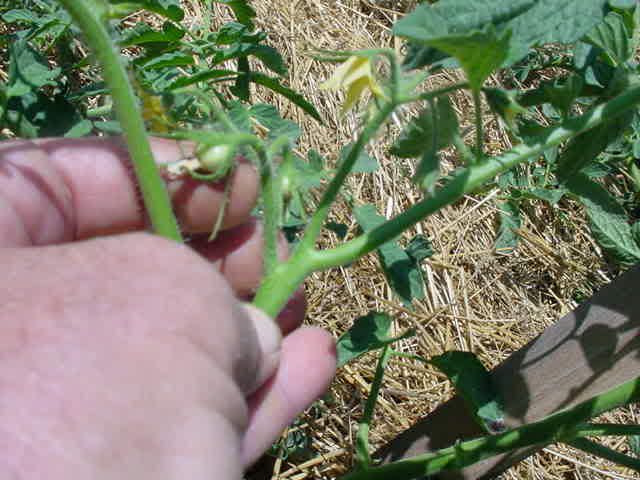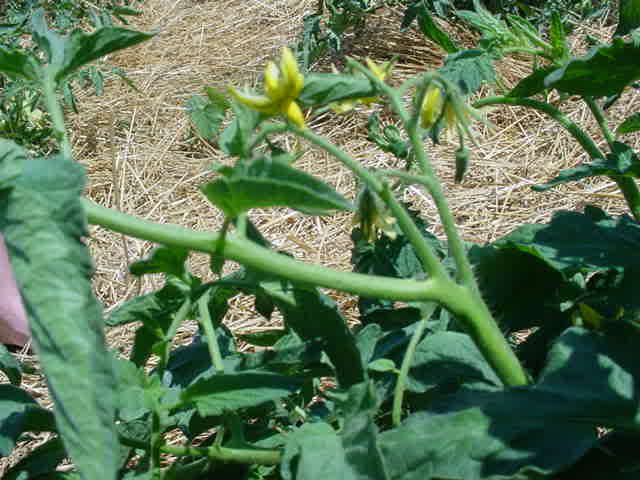

|
|
#61 | |
|
Tomatovillian™
Join Date: Jun 2010
Location: England
Posts: 512
|
Also, I don't know if this has been mentioned in this thread without going back and looking, but it has I think been mentioned at this site before:
Quote:
From: http://www-plb.ucdavis.edu/labs/rost...branching.html |
|
|
|

|
|
|
#62 |
|
Tomatovillian™
Join Date: Jun 2010
Location: England
Posts: 512
|
|
|
|

|
|
|
#63 | |
|
Tomatovillian™
Join Date: Jan 2006
Location: Evansville, IN
Posts: 2,984
|
Quote:
If we were to do so, then the already confused issue of what we call "suckers" or "side shoots" or "secondary stems" or those other stems that emerge LATERALLY from the crotch of a leaf node, becomes even more confusing. The issue of what is a semi-determinate is made clear in the paper linked on page 1 by MAF. Read the paper. Then go count the internode spacings on your indeterminates vs determinates ... and on your semi-determinates if you happen to have one or two. |
|
|
|

|
|
|
#64 | |
|
Tomatovillian™
Join Date: May 2015
Location: Nanaimo , BC
Posts: 961
|
Quote:
There still seems to be some notion of being able to extend production in either determinates / or determinates with the "semi " expression . The extension of production by manipulation or direction of energy/growth into the suckers/lateral /secondary by culture. I am inductively thinking that the determinates with the "Semi" are more flexible and extendable .......but of course will eventually terminate . I still think that the "Semi " expression could be useful / flexible to extend production.
__________________
So Many Tomatoes ...So Little Time ! |
|
|
|

|
|
|
#65 | |
|
Tomatovillian™
Join Date: Jun 2010
Location: Romania/Germany , z 4-6
Posts: 1,582
|
Quote:
|
|
|
|

|
|
|
#66 |
|
Tomatovillian™
Join Date: Jan 2006
Location: Evansville, IN
Posts: 2,984
|
 There is no mistaking a determinate tomato plant. Look at the photo. See the lower flower cluster? The one with the two little fruit sets indicated by my fingers? That is the flower cluster set upon the "internode" space on the meristem between two leaf nodes. Then see the next flower cluster immediately above the one with the fruit set? That flower cluster emerged on the leaf petiole exactly where the subsequent extension section of apical meristem SHOULD HAVE or WOULD HAVE emerged IF the plant were an indeterminate. However, the plant is a DETERMINATE, hence the TERMINAL FLOWER CLUSTER has terminated the forward and upward growth of that meristem. Hence the plant is DETERMINATE. Here is another example of DETERMINATE  In that photo, you can see the same pattern on the primary meristem (main stem or initial growing stem that was transplanted into the ground) BUT then you see a side shoot, or secondary shoot ... a "clone" branch that has emerged from the crotch of a leaf node. This side shoot will repeat the exact same pattern of flowering and eventually ALSO TERMINATE with the exact same terminal flower pattern as did the primary stem ... a flower cluster on a leaf petiole where the apical meristem would grow upward IF THE PLANT WERE INDETERMINATE. But since the plant instead is a DETERMINATE, there is no extension upward with the apical meristem because the terminal efflorescence emerged there instead of the meristem extension. EDIT: These two examples happen to be: first photo: (Cherokee Purple x Summerpink) F2, where I was selecting for determinate expression; and photo #2: (Monte Verde x Neptune) F1, a hybrid cross of two open pollinated determinate tomato varieties. Last edited by travis; June 18, 2015 at 12:47 PM. |
|
|

|
|
|
#67 | |
|
Tomatovillian™
Join Date: May 2015
Location: Nanaimo , BC
Posts: 961
|
Quote:
so the determinate varieties with consistently 1 leaf between inflorences would be considered Compact ? and 2 leaf between inflorescences "regular " determinate ? (up to 5 inflorescences) and the 2 leaf with 6 + inflorescences that eventually terminate are the Semi expression . does anybody know which semi varieties in fact have more "Programed" inflorescences ?? where possibly would we find that out ??? and of course all the above is to be distinct from "Dwarfness" where the space between the internodes is about half of the regular spacing . This is where one can have a small Compact cultivare that fits in a container that is Not actually a dwarf. So one can have dwarf-compact determinate , dwarf -regular determinate , dwarf-semi determinate and dwarf-indeterminate ?? Does anyone know of an actual dwarf "Semi-determinate " ??
__________________
So Many Tomatoes ...So Little Time ! |
|
|
|

|
|
|
#68 |
|
Tomatovillian™
Join Date: Jan 2006
Location: Evansville, IN
Posts: 2,984
|
Here is another clear example of a terminus efflorescence on a determinate plant.
 When you see this or similar arrangement, where a flower cluster (efflorescence) emerges where the ascending apical meristem extension would have emerged on an indeterminate, then you are looking instead at a determinate plant. |
|
|

|
|
|
#69 | |
|
Tomatovillian™
Join Date: Feb 2012
Location: Newfoundland, Canada
Posts: 6,794
|
Just a word of caution, but, I'd be careful not to read too much into the results of a single study, which looked at exactly three varieties and one example each of 'determinate' , 'semi-determinate' and 'indeterminate'. I think other permutations are possible and even common perhaps, if people bothered to count the internodes between clusters who are growing or have grown a great number of heirloom or OP varieties, I think it would be clear.
As regards the question "where would one possibly find that out?" afaik the answer is in your own garden, with the tedium of counting internodes and clusters.  The number of leaves between clusters is variable in indeterminates as well as the others. I have two examples of indeterminates growing this year, with 5 or more leaves between the first and second clusters (Ukraine Purple and Snickers). Also, Zolotoe Serdtse (semi-determinate) has six or seven clusters on the main stem, with only one leaf between clusters, not two. Bursztyn has two leaves between clusters but so far no sign of a terminal bud, so perhaps that is to come, however it is listed in some places as 'indeterminate'. So I think it would be rash to make assumptions about or based on the number of leaves between clusters, observed in one study of three varieties. As Travis has said repeatedly, the DISTINGUISHING factor for a Determinate plant is that the main stem (and side shoots too) form terminal buds instead of getting longer and longer. Semi-Determinate is a type of determinate, ie it also forms terminal buds but has a longer main stem and more clusters, by the present definition six or more. As regards the dwarf question, yes it is genetically distinct (one or more dwarfing genes are possible), and unrelated to the sp or sdt genes, so you can have any combination of dwarf with the other growth habits. Quote:
|
|
|
|

|
|
|
#70 | |
|
Tomatovillian™
Join Date: Sep 2012
Location: Oklahoma
Posts: 4,488
|
Quote:

__________________
Scott AKA The Redbaron "Permaculture is a philosophy of working with, rather than against nature; of protracted & thoughtful observation rather than protracted & thoughtless labour; & of looking at plants & animals in all their functions, rather than treating any area as a single-product system." Bill Mollison co-founder of permaculture |
|
|
|

|
|
|
#71 | |
|
Tomatovillian™
Join Date: Feb 2012
Location: Newfoundland, Canada
Posts: 6,794
|
Quote:
 I'll be standing in for the "sp" gene myself shortly, when the burly indets get as high as I'm lettin em. .. their main stem will surely terminate, regardless.  .... speaking of which, do tell me, how do you manage the Snickers growth habit? Do you prune and train it or let it bush wildly or...????  It's the wierdest thing I've ever seen - six internodes between clusters, but very short internodes, and yow, the suckers that are bushing up off that, but long ones with ten leaves before any buds... It's the wierdest thing I've ever seen - six internodes between clusters, but very short internodes, and yow, the suckers that are bushing up off that, but long ones with ten leaves before any buds...   And shaping up to be tall, afaict, also.... And shaping up to be tall, afaict, also....
|
|
|
|

|
|
|
#72 |
|
Tomatovillian™
Join Date: Jan 2006
Location: Evansville, IN
Posts: 2,984
|
As a follow-up comment to one issue being discussed ...
It doesn't really matter what you call a particular growth pattern because what you arbitrarily decide to call it does not define it in fact. I think we all should have learned that by now after years of what seed company catalog blurbs have incorrectly or irresponsibly designated as the growth habit of so many varieties. On a side issue, yes I think there are more regulating or modifying genes than those so far identified as indeterminate, determinate, and semi-determinate. They just haven't been fully explored and designated with abbreviating letters. |
|
|

|
|
|
#73 |
|
Tomatovillian™
Join Date: Jun 2013
Location: Finland, EU
Posts: 2,550
|
Gold digger, uhh, Gold nugget has only one leaf between the flower trusses... efficient way of maximizing the growing time?
|
|
|

|
|
|
#74 | |
|
Tomatovillian™
Join Date: Sep 2012
Location: Oklahoma
Posts: 4,488
|
Quote:
 I only grew them one year. I let them run wild and just kinda hemmed them in with a Florida weave. They produce a WHOLE lot of foliage, AND a whole lot of tomatoes. Which is probably why they handled the summer heat here without any problems.  The foliage protected the fruit from sun scald even when temps got over 100 degrees. The foliage protected the fruit from sun scald even when temps got over 100 degrees.Because of the later fruit set (started with many leaves as you noted), at first I was concerned, but later when they get going I had TONS of tomatoes. Making sauce almost every day with them! 
__________________
Scott AKA The Redbaron "Permaculture is a philosophy of working with, rather than against nature; of protracted & thoughtful observation rather than protracted & thoughtless labour; & of looking at plants & animals in all their functions, rather than treating any area as a single-product system." Bill Mollison co-founder of permaculture Last edited by Redbaron; June 18, 2015 at 04:41 PM. |
|
|
|

|
|
|
#75 | |
|
Tomatovillian™
Join Date: May 2015
Location: Nanaimo , BC
Posts: 961
|
Quote:
of course I never got to go looking for terminal bud .....at the time .... let me know if it is in fact a semi and you confirm a terminal bud it sure was an interesting one ....... I didn't know Zolotoe Serdtse (semi-determinate) has six or seven clusters on the main stem, with only one leaf between clusters, not two. Sounds like a nice relatively compact plant loaded with fruit ... compared to an actual indeterminate .
__________________
So Many Tomatoes ...So Little Time ! |
|
|
|

|
 |
|
|
